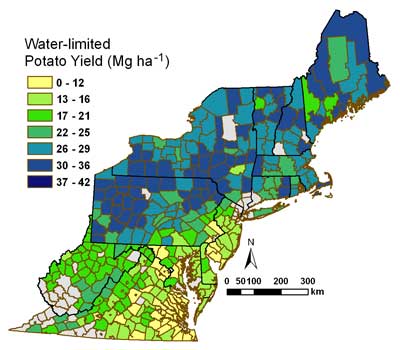GEOG Lecturer, Jonathan Resop, along with scientists at the USDA-ARS Crop Systems and Global Change Lab, recently published a manuscript in the January-February 2014 issue of the Agronomy Journal. The paper is titled "Biophysical Constraints to Potential Production Capacity of Potato across the U.S. Eastern Seaboard Region." The research paper has since been featured on the website of the American Society of Agronomy (https://www.agronomy.org/) to be highlighted as part of a cover story for a future issue of CSA News (https://www.agronomy.org/publications/csa-news/). The abstract is as follows:
The Eastern Seaboard region (ESR) of the United States is densely populated and depends on imported food. Agricultural systems are vulnerable to uncertainties such as environmental conditions, climate change, and transportation costs. Local populations could benefit from regional food systems as a way to provide security; however, the potential production capacity of the region would first need to be quantified. Potential production capacity for a specific crop, potato (Solanum tuberosum L.), was explored in two ways: expansion of the harvested land area and closing the yield gap between observed and potential yield. Potato production was assessed from Maine to Virginia for current land use (land under potato cultivation) and potential land use (other cropland). Simulations were based on two water availability scenarios: limited and nonlimited. A geospatial model implementing the explanatory model SPUDSIM estimated crop production (crop yield, water use, and N uptake) based on spatially variable input data (weather, soil, and management). Potato production was simulated in 35 potato-producing counties and in 346 counties with cropland. Under water-limited conditions, the response surface of production showed greater yield in the northern ESR states (median 28.24 Mg ha–1) than in the southern states (median 15.41 Mg ha–1). Resource requirements (water and N) and biophysical constraints (climate and soil) to production were also evaluated. In general, potato yield was negatively correlated with higher average seasonal temperatures and denser soil profiles. The results from this study will be valuable for regional policy planners to assess the capacity of the regional ESR food system.
To read the entire article, please visit this link: https://dl.sciencesocieties.org/publications/aj/abstracts/106/1/43.
To read the feature by the American Society of Agronomy, please visit this link: https://www.agronomy.org/story/2014/may/mon/new-tool-simulates-crop-yields-across-entire-east-coast.


